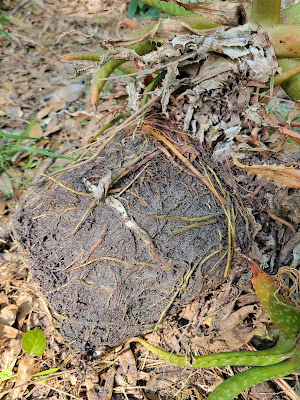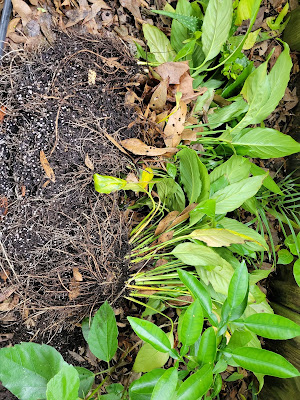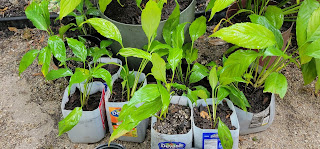- Get link
- X
- Other Apps
- Get link
- X
- Other Apps
Have you ever had a rootbound plant? Wondering what does rootbound mean? Rootbound is when a plant has grown too big for its pot, and the roots are just circling the pot on the inside. When you pull a rootbound plant out of its pot, you will likely find that the roots have enclosed the little soil left, and that the rootball has taken the shape of the pot.
 |
| A rootbound aloe vera plant |
Re-potting a plant can seem daunting, and honestly sometimes re-potting a plant can be quite the task, especially if it is an old plant. However, with a few simple steps, you can re-pot a plant whether it is rootbound or not, either by putting it into a larger pot or by dividing it and getting more plants while you're giving your plant more room to grow.
How To Re-pot Plants:
- You can re-pot a plant on a table, or if it is a large plant, try to do it in a gardening bed, so that any spillage stays in the bed.
- Lay your potted plant on the side and start knocking all around on the side.
- Gently lift up the bottom of the planter, and see if you can knock out the plant.
- If the plant does not come out, repeat.
- You can take your small shovel and try to loosen up the sides a little on the inside of the pot.
- You may have to tug a little on the plant once you put it on the side, but be careful not to damage the plant.
- Once you've gotten the plant out of it's pot, it's time to put on your gardening gloves.
- Some plants that grow by rhizomes (or suckers) such as shell ginger, lilies, bird of paradise, elderberries and others may need a sharp shovel to get the rhizomes divided, just make sure that each piece have ample roots.
- In most cases, the best way to divide a plant is to gently separate the roots with your fingers, as this is a gentler way of dividing.
- If your plant is simply rootbound but not ready for division, start dividing the roots from the bottom. If the plant is so rootbound that it is hard to separate the roots, you may need a pair of sterilized sheers or scissors (Just pour some rubbing alcohol over your tool to clean it first).
- Once the roots have been separated and the plants have been divided, it is time to prepare the new pots.
- Make sure your new planting pot has holes for drainage, so the plant roots won't rot.
- Add shards of old pots, large seashells or rocks to the bottom of the pot so that the drainage holes won't clog.
- You can use store-bought potting soil that fits your need, or you can make your own homemade compost. For our indoor plants I use a sterilized organic compost. For our outdoor plants, I use a combination of decomposed wood chips and compost from our compost pile, which includes chicken manure.
- Fill the bottom of the pot, then set the plant in the pot, and start filling up around it.
- When the pot is firm, gently press on the soil around the plant to remove any large air spaces.
- Make sure that the plant is at the same level as it was, before you removed it from its original pot. Don't cover a greater amount of the stem, as this can make it rot.
- Once done, water the plant thoroughly and leave it in part shade for a few days, so that it can get used to it's new location.
- Once you are sure that the plant has settled, return it to it's previous location.
- Some plants love being transplanted, but other plants such as elderberries, papaya and tree philodendrons often suffer from transplant shock, and on some cases it can take weeks before the plant recovers.
 |
| Rootbound peace lily |
 |
| Dividing a rootbound peace lily |
 |
| The rootbound peace lilly plant was returned to its pot with new soil, after having been divided into many new plants. Some to be sold, some were planted in beds and a few became houseplants. |
Transplant Shock
- Plants that suffer from transplant shock may look as if they are dying for the first week or so after transplanting, and they may loose all of their leaves.
- Make sure to water sufficiently, and don't leave the plant in direct sun until it has settled.
- I always try to do my re-potting, whenever I know there is rain in the forecast, because newly transplanted and re-potted plants need plenty of water, until their roots have adjusted to the new location.
- To prevent transplant shock for sensitive plants, try to keep as much of the previous growing medium as possible and try not to disturb the plants too much.
- Papayas especially like the pressure of rain water on their roots, so I try to only transplant papayas right before days with rain.
- Most of the time the plants will recover within 1 - 4 weeks, but the bigger the plant the longer it can take. Don't lose patience, just keep taking care of the plant, and before you know it you should see tiny new leaves emerge signaling that the plant is happy again. This past summer I dug up and moved a huge ten-year old tree philodendron for a neighbor. One section was moved to our land, where it quickly recovered in the shade with damp soil. The other section was moved to our neighbor's sunny front yard, and it looked as if it was dying for at least 6 weeks, until it slowly began to recover. Three months after transplanting, the tree philodendron is thriving, but my neighbor was tempted to get rid off it for a while.
Re-potting plants can be hard work, but the results are healthier plants, and it is a great way to get more plants without spending any money.
For more garden tips, checkout our side navigation bar.
Garden Tips
Growing Elderberry
Growing Papaya
Growing Peace Lillies
Growing Vegetables
Repotting Plants
Sustainable Living
- Get link
- X
- Other Apps
Popular Posts
Troy-Bilt Wood Chipper - Super Tomahawk = Our No. 1 Tool For Better Composting
We could not have gotten as far with our sustainable land clearing and composting, if it had not been for our power horse, our Troy-Bilt Super Tomahawk wood chipper with its 8 HP Briggs & Stratton motor. We purchased this 31+ year-old wood chipper off Craigslist for $200 about a year and a half ago, and it is still going strong. Troy-Bilt Super Tomahawk Wood Chipper
Zone 9A/9B Gardening Calendar - North East Florida Planting Schedule
Gardening in Florida is a very different experience than gardening in the rest of the country, and growing fruits and vegetables in North East Florida is a very different experience than gardening down south. It has taken us about five years to adjust to the zone 9 planting schedule, and while there are many zone 9 garden guides out there, we felt that there was a need for a simple, user friendly zone 9A/9B planting calendar.
How To Remove Palmetto Palms
If you have ever tried to remove a palmetto palm by cutting it down, you will likely have realized that removing palmettos is tricky. So, when we got ourselves a piece of land with about half an acre of these wonderful palmetto palms, also known as saw palmettos or shrub palmettos, we knew that we had a challenge on our hand.
Where To Find Free Nursery Pots and Planters
Every gardener needs something for their plants to grow in. Whether it is directly into the soil in your garden, into a garden bed, nursery pots, ceramic pots, terracotta pots, or if you get more creative, you need something for your plants to grow in. That's why we're always looking for free nursery pots and cheap planters.
How to Transplant a Banana Tree
Wondering how to transplant a banana tree? I know, it's not a tree, so wondering how to move a banana plant? Bananas are pretty easy to move, and they're pretty hardy too. The best time to transplant a banana plant is in the rain season, but I've planted and re-planted banana plants all year round, just remember to water well if it doesn't rain. Last year I planted a small ice cream banana pup in front of our home, but I was negligent in my research and didn't realize just how big it would get. I prefer moving banana trees in the rain season, but the leaves were getting too close to our power line, so it had to be moved. The roots of banana trees aren't very deep, and they will quickly re-establish, if you give them some love and water. The root ball of a 1 year old Grand Nain banana We've been preparing an area at The Land for banana babies, since we now have six different banana varieties at the house and these are beginning to give us pups. Today was th...
How to Grow Mulberry from Cuttings
Our favorite mulberry bush is in danger of eradication, so for the past year or so we have been growing mulberries from cuttings. Our children love eating fruit straight from the trees and bushes, and while we lose wild areas every day to construction and development in our community, we still have a few areas left untouched for now. Some mulberry trees are simply too tall for great mulberry picking, but this one mulberry bush is low and spread thick like a bush. Mulberries look similar to blackberries, but they are sweeter and juicier. They do not hold up well, which is why you will not find them in the stores, but we freeze any leftover mulberries to use in our weekly smoothies. Wild blackberries and wild mulberries We've taken cuttings three times from the mulberry bush. We waited until after fruiting last spring to take the first cutting, and the second time was about four months after fruiting. The third set of cuttings we took was in late winter, just as the mulberry bush had...
Save Your Papaya Trees After Cold Damage
Papayas are susceptible to high winds and freezes, but do not let that prevent you from growing papayas in zone 9a or 9b. In our experience, papayas are pretty cold hardy, but they do not like temperatures below freezing, especially not a sustained time with freezing temperatures. Temperatures below 40 degrees F/4 degrees C will make the papayas begin to look sad, but it is not until the temperatures hit freezing, that the papaya trees will sustain damage enough to kill the papayas. Last winter we had two quick freezes here in St. Augustine (growing zone 9a), and while our tallest papayas looked sad after the first freezing night, it was not until the second freeze that they were defeated. How to Save Papayas After a Freeze: After a freeze wait and see for a week or two to determine where you need to cut your papayas. If another freeze is imminent before your wait or see period is over, make the cut low, cover and protect. Look for new growth or a firmer trunk. Cut the papaya trun...
How To Make Permanent Plant Tags out of Recycled Plastic, Aluminum & Copper
We have lots of citrus trees in the garden, but until they produce fruits, they will be just that - citrus trees - because I have no clue what type they are, since most of my plant tags never held up. I've tried many different plant tags from chalk signs to plastic and the infamous popsicle stick. All failed the test of time, but when I started selling plants, I had to come up with some way to identify the plants and trees to make it easier for the customers. I wanted something that would last at least 6 months, could stand up against the weather, and I began looking for plastic plant tags. I had a hard time finding affordable, recycled plastic plant tags, so I decided to create my own permanent plant tags . (< see video) We've also begun a complete revamp of our front garden, which means more plants, and we've got lots of plants and trees growing for our future garden at The Land. For these plants, I wanted permanent plant labels that could contain both the common name ...
Finding Free Plants on Craigslist
If you are looking to add new plants to your garden, make sure to keep an eye out for free plants in the free section on Craigslist. We have picked up free plants a few times, when someone is clearing out their garden, and in return we make sure to post items as well. This morning I spotted a post for a free estate sale on Craigslist, and it included potted plants. It was in a fancy neighborhood by the beach, where an old house was being torn down to build a new huge one. We picked up several knick knacks such as plates, vases,paintings, lamps, a coat rack, a book shelf and more, and we also brought home as many big pots and plants as our mini van could fit. Free pots and plants These pots were the big ceramic kind that are not in our teacher's budget, and there were lots of different plants too. The plants need to be re-potted and re-nourished, but we've added some new plant species to our garden, which we will make sure to create more plants from trough seeds and ...
How To Grow Papaya From Seeds
Papaya is one of the easiest fruit trees to grow, if you provide them with the right conditions. Here in North East Florida we are in growing zone 9, and while papaya prefer warmer winters than we have here, we have still had great success. Eat a papaya, grow a papaya. We got the idea to grow papaya from seeds, when one of our children began suffering from constipation. The pediatrician suggested that we added papaya to the diet, because papaya is a diuretic. However, papaya can be expensive often costing $5 for a single fruit, and sometimes papaya can be hard to find at the store. For a frugal family of seven, this means papaya is a luxury, so we now make sure to have papaya trees of all sizes planted around the house. Each papaya fruit has a myriad of seeds, and they are so easy to start. Papaya does not like to be transplanted, although we have been able to do so with varying degrees of success, so plant the papaya directly in the soil outside. If you are in zone 10+, you ...











Comments
Post a Comment